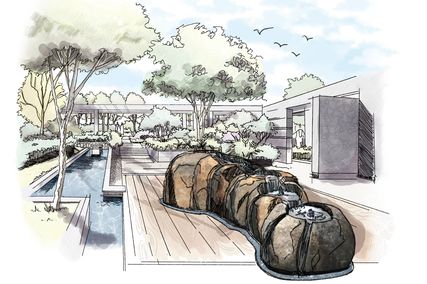The expertise that architects and designers bring to the work and processes of government has significantly changed since the era when public works departments were engine rooms for the design and production of public buildings, housing and infrastructure. The dismantling of public works offices that coincided with the neoliberal turn in built-environment governance is often associated with diminished investment in civic architecture and the public realm. Yet there is an expectation that governments will be responsible custodians of the built environment and should play a funda-mental role in setting standards and conditions for high-quality development. This dossier recognizes the need for a new understanding of the contribution that architects and designers are making to address this challenge from a diverse array of roles and positions in government.
The re-establishment of government architect (GA) positions as advisory roles at the turn of the millennium reflected a distinct shift in how governments influence the quality of the built environment.1 This has since been theorized under the umbrella of “design governance” – a term that captures the multi-stakeholder context of development in contemporary liberal democracies and the important role of advisory and advo-cacy tools and processes in achieving good design outcomes. Yet there is a gap in current knowledge about the scope of architects’ and designers’ contribution to design governance in Australia, a lack of basic data on the footprint of design expertise in the public sector, and a need for reflection on the significance of this shift in built-environment governance for the evolution of the profession.
The opportunities for architects in the arena of design governance should not displace larger conversations about the role of government in the delivery of the built environment for the public good. However, it is an under-acknowledged dimension of the profession’s agency. The contributions to this dossier address several dimensions of design governance of relevance for architecture, including the value of design review and design-led procurement processes, the political and resourcing challenges of working in and with government, the importance of justifying and communicating the value of good design in diverse ways, and the ways that the specific expertise required to achieve good outcomes can be better recognized in and beyond the profession.
State and territory GAs are arguably the most visible of architects working in government today, and their offices are important points in an expanding design governance ecosystem that includes design, property and project managers, policy advisors, and design review panel experts contributing at both state and local government levels.2 We begin the dossier with a roundtable involving the current state and territory GAs. For the first time, all these positions are held by women.3 While this is noteworthy and deserves recognition, it is also, as remarked by South Australian GA Kirsteen Mackay, “an anomaly and not representative of the state of the profession … We need to encourage broader diversity in the profession [to] ensure that advice about the shape of our built environment is genuinely inclusive and respectful.” To this, we would add the need for a more diverse understanding of what constitutes professional leadership.
Where many GA positions began as part-time roles in non-existent offices, today the six GA offices around Australia support approximately 50 full-time equivalent positions, with another 50 full- time equivalent positions connected through other parts of government. However, it should be noted that resourcing continues to be precarious, and there are no longer GA positions in the Northern Territory or Tasmania.4 There is also a significant disjunction between the budgets of the GA offices (approximately $7 million in total), the billions of dollars of work that they advise on,5 and indeed the scale of the construction sector they seek to influence, which is estimated to exceed $360 billion.6
Design review has become a key function of GA offices around the country. More than 350 experts participate in the design review panels convened by the GAs, and this figure does not account for the many panels operated by other government authorities and in local government jurisdictions. Design review processes are typically supported by design guides or policies developed to articulate agreed criteria for good design so that project evaluation is less vulnerable to vested interests and political agendas. Yet, design review involves more than just checking off a list of criteria and is not only about supporting an individual project’s design resolution. Here, Stuart Harrison, Jocelyn Chiew and Emma Kirkman explore what makes a successful panel by sharing case studies that highlight their important role in raising expectations for design quality, and building capacity and confidence among diverse stakeholders.
The adoption of design review as one of the most prominent design governance tools in Australia owes much to the processes developed by the UK Commission for Architecture and the Built Environment (CABE). While CABE resources continue to be utilized by GA offices around Australia, we ask: What other international benchmarks can Australia learn from? Our interview with Flemish GA Erik Wiëers discusses the Open Call process developed to prioritize design quality in public procurement in Flanders. As an independent and trusted advisor to government who also seeks to advocate for innovation and design excellence, the Vlaams Bouwmeester faces similar challenges to Australia’s GAs. The legacy of the Open Call provides evidence of the long-term impact that delivery tools can have in changing placemaking culture and offers a point of comparison for those being deployed in Australia.7
Finn Williams’s description of the role of architects and designers working in government as an “upstream” design practice8 is another useful formulation that has been taken up by Monash University educators Timothy Moore, Andy Fergus and Mel Dodd. It captures an oft-remarked frustration among architects in government about their capacity to influence strategic decision-making at the point where design briefs and budgets are determined. The lack of visibility of career paths for architects working in government sits in stark contrast to other built-environment professions, especially planning.9 Here, Moore, Fergus and Dodd interrogate how a new understanding of public practice that moves beyond a binary division between the public and private sectors can inform the careers of future architects in Australia. It also raises broader questions about how professional regulation and education together can embrace more diverse career pathways and experience and recognize the specific expertise of design leadership, without eliding the design skills they are founded upon.
In the final contribution, Sheona Thomson interviews Elizabeth Watson-Brown, member of parliament and Australian Greens spokesperson on infrastructure, transport and sustainable cities. In her first speech to parliament, Watson-Brown reflected on the formative experience of her architectural education in shaping her commitment to environmental justice for future generations.10 Here, she reveals her desire not only to take a sustainable built-environment agenda into federal parliament, but also to reckon with the more fundamental challenge of redesigning politics.
Design governance roles offer architects the opportunity to have a greater impact on the quality of the built environment. This dossier seeks to recognize these roles as well as the design leadership expertise they require, and the career paths that can lead there.
1. In New South Wales, the GA position has been maintained since the colonial era. The Office of the GANSW transitioned to operating primarily in an advisory capacity in 2017.
2. See, for example, the Design Excellence Network Victoria (designexcellencenetwork.org) and the Designers in Government group initiated by Callantha Brigham in New South Wales; Kate Rintoul and Alice Stroemstedt, “Designers in Government,” Architecture Bulletin , vol. 78, no. 2, 2021–22). Available at architecture.com.au/archives/reading-architecture/designers-in-government.
3. Several women have held Deputy or Associate Government Architect roles where they have existed, including: Helen Lochhead (Deputy Government Architect NSW 2007–16), Melinda Payne (Associate to the Government Architect WA 2005–22), Shelley Penn (Associate Victorian Government Architect 2006–10), Jill Garner (Associate Victorian Government Architect 2010–15), and Kirsteen Mackay (Associate Government Architect SA 2013–15). See Sara Stace, “Wanted: Ms Government Architect,” Parlour: Gender, Equity, Architecture , 24 January 2014. Available at parlour.org.au/opinion-analysis/wanted-ms-government-architect.
4. Michael Keniger’s overview of the state of the GA positions around the country in 2012 provides useful background on the political and resourcing challenges faced by new GAs in their first few years: Michael Keniger, “Australia’s Government Architects: A political position,” Architecture Australia , vol. 101, no. 6, November/December 2012. Available at architectureau.com/articles/a-political-position.
5. GAs are increasingly seeking diverse ways to communicate the public benefit of their contribution to good design outcomes. For example, see SGS Economics and Planning, The Value and Benefits of the OVGA: 2021 Refresh , 13 August 2021. Available at ovga.vic.gov.au/value-and-benefits-ovga-sgs-report-2018-2021.
6. John Sharkey et al., The Health of the Australian Construction Industry: Research Report (University of Melbourne: Melbourne, 2020). Available at law.unimelb.edu.au/__data/assets/pdf_file/0005/3501086/Health-of-the-Australian-Construction-Industry-Research-Report.pdf.
7. See, for example, Robert Freestone, Gethin Davison and Richard Hu (eds), Designing the Global City: Design Excellence, Competitions and the Remaking of Central Sydney (Singapore: Palgrave Macmillan, 2019); and Leon van Schaik, Geoffrey London and Beth George (eds), Procuring Innovative Architecture (London: Routledge, 2010).
8. Finn Williams, “Designing Upstream: Rebuilding agency through new forms of public practice,” Architectural Design, vol. 88, no. 5, 2018, 104–9; doi: 10.1002/ad.2350.
9. Around half of the 5,400 planners identified in the 2001 Census worked in local government, 30 percent worked in the private sector, 22 percent worked in state and territory governments and the remaining 2 percent worked in the Commonwealth. See Planning Institute of Australia, “Findings and recommendations of the national inquiry into planning education and employment,” August 2004, planning.org.au/documents/item/294.
10. Watson-Brown’s first speech to parliament can be viewed at youtube.com/watch?v=jqHlWI95cjA (accessed 9 January 2023).
















